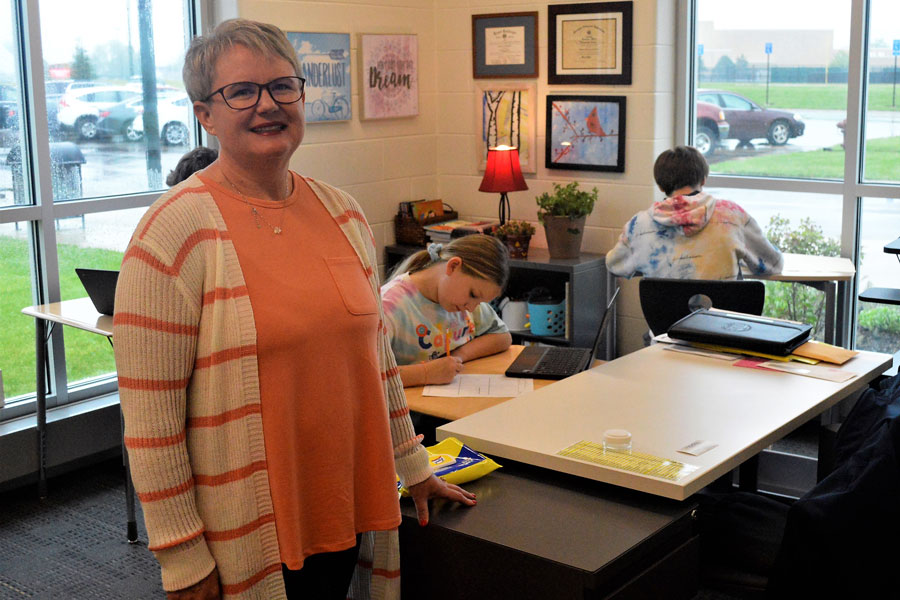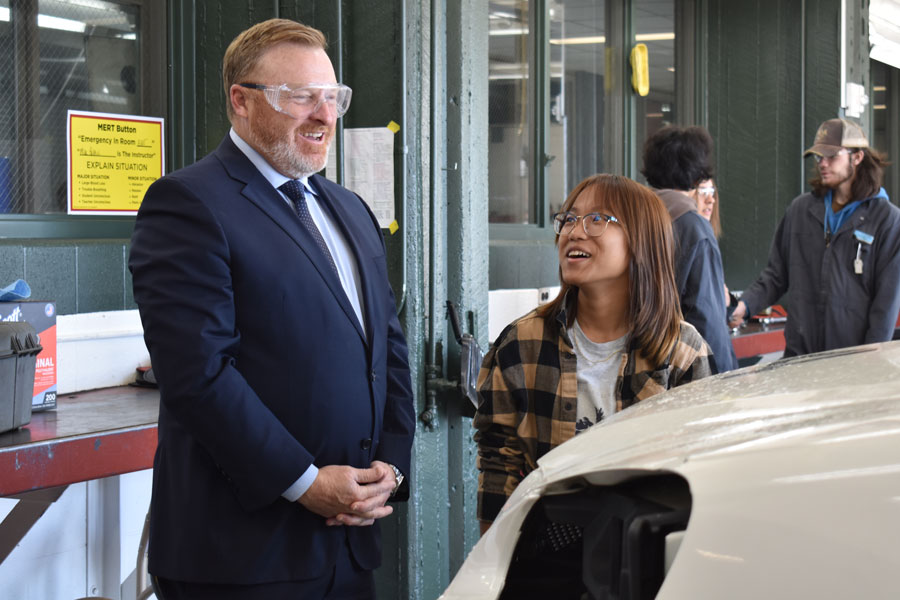Editor’s note: This is the first in a two-part series on the K-12 teacher shortage and its effects in Kent County. Read the 2nd part here.
All Districts — Jackie Domeier has only ever wanted to be an educator. The first-year teacher at Forest Hills’ Northern Trails loves her job, and can’t see herself doing anything else, but she’s approaching her profession with a wait-and-see attitude.
What’s she waiting for?
She wants to give it five years to determine if it’s sustainable, and if she can fend off burnout long enough to make a better living.
Domeier is starting her dream career in the midst of a teacher shortage that’s plagued the county, state and nation for years.
While hiring institutions and schools of education try to drum up more interest in the profession through grants and hiring incentives — such as the recently launched West Michigan Teacher Collaborative — teachers like Domeier are on the frontlines, covering larger class sizes and juggling additional responsibilities to bridge the gap.
‘I’ve always seen myself in this field. Despite the challenges, and seeing how there’s so much of a shortage, I’m still really optimistic about it.’
— Jackie Domeier, first-year teacher at Forest Hills’ Northern Trails
The shortage has amped up stress and expectations associated with an already demanding job, and the impacts have been felt at every district, irrespective of socio-economics or demographics. Domeier — who teaches fifth-grade science and social studies, alternating between English and Spanish — did her apprenticeship with Southwest Elementary at Grand Rapids Public Schools before taking her current post with Forest Hills. She said the shortage is impacting both districts equally.
“Honestly I’d say they’re pretty comparable,” she said. “I think it’s something that’s just across all school districts.”
Domeier was aware of the shortage when she entered the profession, but it didn’t make her question her decision to become a teacher.
“It didn’t deter me, but it is … a concern when I see that a lot of young people are leaving the profession,” she said. “It does make me a little bit nervous, but I feel that despite that, I still want to give this career a chance. It’s something I’ve always wanted to do, for a very long time.”
Still, she said, the shortage is a “really big problem.”
The Issue(s)
Better pay? More flexible hours? An easier path to certification for prospective educators? More respect and appreciation from parents and community members?
What will it take to bring people back into the teaching profession? All those things and more might not be enough to do the trick, according to some, while others are hopeful that progress is being made.
As of late September, there were more than 400 vacant positions at Kent County-area public schools, according to job listings on Kent ISD and Grand Rapids Public Schools websites.
GRPS, which is the largest district in the region, had about 117 teaching vacancies and roughly 130 open positions overall. The shortage is affecting not only teachers, but also paraprofessionals, bus drivers and other school employees.
The shortage itself was the result of a slow build, said Karl Nelson, executive director of pre-K-12 instructional leadership for the northwest quadrant of GRPS.
“This is not something that automatically just happened. This is something that has been happening over the course of time. Probably slowly,” Nelson said. “There are a varied number of reasons why … we have the vacancies we do.”
He said COVID-19 might have exacerbated things, but the shortage has been going on since long before the pandemic, with many contributing factors at play, including workload and a general lack of appreciation for educators.

But it has a lot to do with compensation, said veteran teacher Jayne VanderKlok.
“We’ve lost young teachers over the last few years because they’ve had job opportunities pop up where they could make more money,” she said.
Now in her 29th year of teaching special education at Kenowa Hills Middle School, VanderKlok is also the president of the Kenowa Hills Education Association and treasurer of the Kent County Education Association.
“I think a lot of it comes down to … the cost of college compared to potential salary earnings,” she said. “When I graduated in 1993, (college tuition) was about $13,000 a year and my starting salary was about $28,000. So I would be earning double what it cost to go to college.”
Now, tuition is typically “north of $50,000,” she said, and most starting teachers — including Domeier — are bringing in around $42,000 per year as a starting wage.
‘Education funding can’t be based on what is left over in a budget; it needs to be a priority.’
— Jayne VanderKlok, teacher and president, Kenowa Hills Education Association
In some cases, salaries can reach around $100,000 per year, but that typically requires National Board Certification, 25 years experience with a school district, and either multiple master’s degrees or a doctorate, VanderKlok said.
In a sense, for many just out of college, education could be considered an almost “fiscally irresponsible” career choice, she said.
Ron Gorman, assistant superintendent of instructional services for Kent ISD and former interim superintendent of GRPS, also pointed to compensation as a “major challenge.”
“I don’t believe that the teaching profession has had similar salary increases as other professions,” he said. “If I’m going to go to school for four years, and then I have to student teach, and pay to student teach — if I have to do all that and come out and make a dollar amount where I can’t pay back my loans, that’s going to be a deterrent as well.
“The goal is to make a good living, take care of your family, get a home, do all of these things. But after four and-a-half years of college, you can’t do that.”

Effects Felt Everywhere
The shortage is prevalent across the board, Gorman said.
“There used to be a time when it affected some districts more than others, and now it affects everybody,” he said.
Both Gorman and Nelson cited low enrollment in college education programs as a contributing factor.
“There just aren’t enough graduates of schools of education,” Gorman said. “When I was coming out of school in 1997, it was difficult to get a teaching job. There just weren’t that many openings, and there were many candidates. That’s changed significantly. We’ll have multiple positions and a handful of candidates.”
VanderKlok traced back the impacts of the shortage in Michigan to legislative decisions made in the early 2010s under then-Gov. Rick Snyder.
“The roots of the teacher shortage began when schools were underfunded by the State Legislature, which in my opinion began with Rick Snyder’s budgets,” she said. “When the rate of pay does not keep up with the cost of a college education, college students are not going to choose that career path. Education funding can’t be based on what is left over in a budget; it needs to be a priority.”
‘I don’t believe that the teaching profession has had similar salary increases as other professions.’
— Ron Gorman, Kent ISD assistant superintendent of instructional services
VanderKlok referenced a teacher tenure reform policy signed by Snyder in 2011 that ended the “last in, first out” practice, requiring administrators to consider factors such as classroom effectiveness when making firing or layoff decisions. The legislation placed an added emphasis on performance, assessments and analytics. VanderKlok said it turned off many longtime educators and prospective newcomers.
Gov. Gretchen Whitmer has made some changes to give experienced teachers more leverage at the bargaining table, and continues to up the education budget. VanderKlok sees these decisions as a “step in the right direction” that could make teaching more appealing for college students who “want to make a difference in our society, but … also want the ability to own their own home and graduate from higher education without being buried under mountains of debt.”
According to the Michigan Department of Education, enrollment in educator preparation programs has dropped dramatically over the last 10 years, declining from 23,203 students in 2011-12 to a low of 9,512 in 2016-17. Enrollment has slowly increased since then, up to 14,829 in 2021-22 — an increase of 30 percent since 2018-19 compared to 7 percent nationally, according to MDE. However, that’s still well below 2011 levels.
‘Still Optimistic’
As for Domeier, she’s choosing to look on the bright side, partly because the thought of leaving the field is more daunting than staying in it.
“I have spent so many years working with students, studying to become a teacher,” she said. “Even though the shortage of teachers is prevalent, it is simply the reality, and I choose to work with the support from others and the resources I have instead of dwelling on it. If I quit so early on, just when my career had started, all of my hard work preparing would have been for nothing.”
Domeier’s passion for education was sparked by her parents, who are both educators. Her father, Randall Domeier, is a longtime Spanish teacher at Byron Center, while her mother, Lucía Bernal-Domeier, is a paraprofessional for English-language learners at Byron Center elementary schools.
She grew up envisioning a life like theirs.
“My dad always made it seem like a sustainable career,” she said. “He was able to sustain our family with the salary he had.”
But until she gets more credentials or more experience under her belt, that level of stability could elude her.
Hence the five-year plan.
“It’s too soon for me to determine whether I’m paid adequately, but everyone knows that teachers deserve more pay than what they’re currently getting,” she said. “If I continue with this, it actually can be a sustainable career. It just takes time to get to that point.
“As I get my master’s, as I work for more years, my pay will gradually increase.”
For now, though, it’s a bit of a struggle.
“I still live at home to save money,” she said. “I can’t imagine having to pay rent and utilities.”
Domeier is determined to make things work.
“I’ve always seen myself in this field,” she said. “Despite the challenges, and seeing how there’s so much of a shortage, I’m still really optimistic about it.”
If her five-year plan does result in considering other career paths, she’s not sure what they’d be. She said she’d probably still want to work in education, perhaps obtaining her ESL certification so she can work with multi-language learners in smaller class sizes.
“I knew I wanted into this career,” she said. “I don’t really know what else I would do if I weren’t in this field.”
Read more from Issues in Education:
• Teacher-designed classrooms help students feel supported, calm and creative
• ‘Feed the kids’









